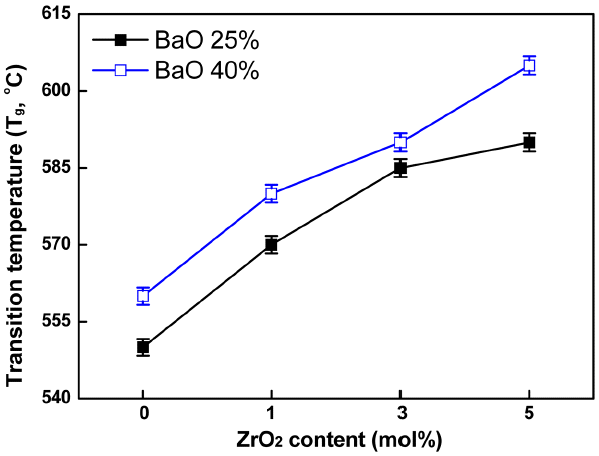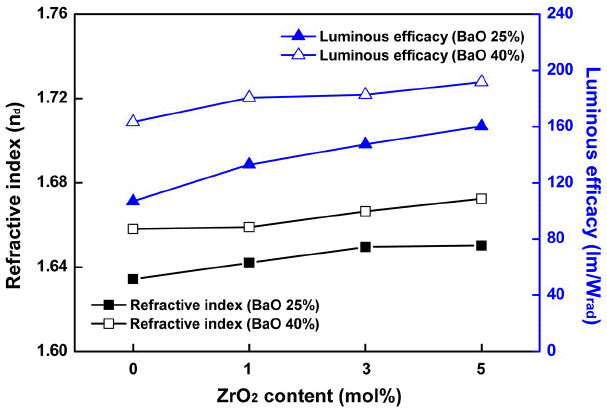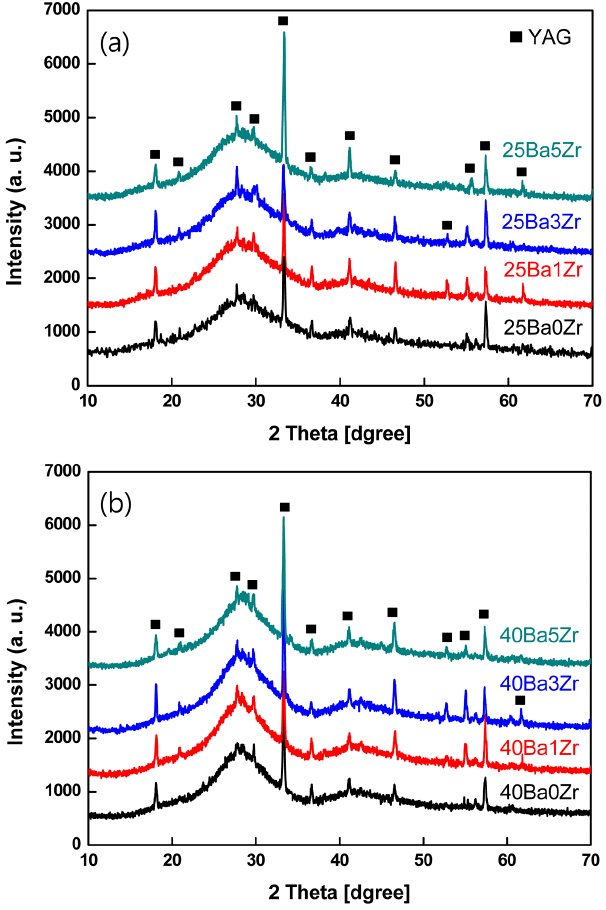1. Introduction
White light-emitting diode (LED) has been emerged as alternative lighting source that will replace existing lighting system because of long lifetime, wide color gamut, energy saving and environment-friendly characteristics.1-3) There are two ways to produce the white light. Combination of red and green phosphors and blue LED or yellow phosphor and blue LED.4,5) White LED which has been commercialized uses the method to directly coat on blue LED chip using YAG (YAG: Ce3+) phosphor which is doped with Ce3+ and epoxy resin or silicon binder. The problem with such method is decrease in lifetime and luminous efficacy due to deterioration of epoxy resin or silicon binder by heat directly transferred from LED chip.6-8) To deal with such problem, remote-phosphor method with phosphor distanced from LED chip began to be used because it reduces the heat transferred to phosphor from LED chip so as to enhance the lifetime and luminous efficacy. Besides, the study on using the glass as the host of phosphor has been underway. Since the glass is generally not sensitive to temperature variation, color conversion glass in the form of phosphor enwrapped with the glass is able to prevent the change in character and deformation.9) However, the difference in refractive index between glass and phosphor causes the light scattering at the phase boundary that reduces the luminous efficacy.1,10)
In this study, ZrO2, which has high refractive index, was added to BaO-ZnO-B2O3-SiO2 system to reduce the difference in refractive index between the glass and phosphor. And refractive index of the glass depending on ZrO2 was checked and the effect of change to refractive index on luminous effiicacy of color conversion glass was evaluated.
2. Experimental Procedure
Based on basic composition with the content of BaO, 25 and 40 mol%, respectively, ZrO2 was added by 1, 3 and 5 mol%, respectively which was followed by dry-mixing for 12 h and melting in alumina crucible at 1400°C for 2 h. The specimen for measuring refractive index was prepared by pouring melted glass into graphite mold, and that is annealed at Tg for 2 h. The annealed specimen was cut and polished into 30 mm × 8 mm × 3 mm. To produce glass frit, the melted glass was rapidly quenched by twin-rollers, it’s crushed using alumina pot and ball for 2 h. Crushed glass was sieved to make particle diameter less than 53 μm. Each glass frit was mixed with 5wt% YAG, and the mixed powder was placed into a stainless steel mold. Subsequently, mixed powder was pressed and then sintered at Tg + 100°C for 30 minutes. All color conversion glasses obtained were cut and polished into diameter 25 Ф with thickness 1 mm for evaluation of characteristics.
For evaluating the physical properties of the glass, Tg was measured using a differential thermal analysis (DTG-60H, Shimadzu, Japan) method and refractive index of the glass by ABBE refractometer (2T, Coretech., Korea) at 589.3 nm wavelength. Characteristics of color conversion glass, such as luminous efficacy, correlated color temperature (CCT) and color rendering index (CRI), were evaluated using integrating sphere photometer (LEOS (OPI-100), WITHLIGHT, Korea). In producing color conversion glass, chemical reaction between the glass and phosphor that might occur during sintering process was identified using high resolution XRD (HR-XRD, X’pert MRD, Panalytical, Netherland)
3. Result and Discussion
Glass transition temperature (Tg) and refractive index (nd) are shown in Table 1. Name of sample was indicated in number by describing the content of BaO and ZrO2 (mol%). For instance, if the content of BaO is 25 mol% and ZrO2 is 1 mol%, it’s indicated as 25Ba1Zr.
Figure 1 shows the result of glass transition temperature (Tg) depending change to the content of BaO and ZrO2. As a result, it’s confirmed that the greater the content of BaO and ZrO2, the higher Tg. Generally, increase in nonbridging oxygen within glass network weakens the glass. BaO increases nonbridging oxygen, but Ba2+ stabilizes the glass network in this study and thus, increase in Tg seemed to be attributable to increase in contents.11-13) ZrO2 plays the role of both the forming agent and intermediate agent and Zr4+ increases bridging oxygen within glass network and thus, the more content of ZrO2 the higher Tg.14,15)
Figure 2 shows refractive index of the glasses depending on variation in the content of BaO and ZrO2. It’s well known that more content of BaO and ZrO2, the higher refractive index.10-15) To increase the refractive index of the glass based on such fact, the content of BaO was increased from 25 mol% to 40 mol% and refractive index of the glass depending on change to the content of ZrO2 was checked. Consequently, refractive index of the glass when the content of BaO was 40 mol%, was higher than 25 mol%. In addition, in line with ZrO2 increasing from 0 mol% to 5 mol%, refractive index was increased accordingly.
Figure 3 shows relative PL spectra when exciting color conversion glass to 450 nm blue LED. A broad band with the center at 550 mm in a PL spectrum indicated a light-emitting spectrum due to transition of Ce3+ which was doped in YAG (5d → 4f).1) All color conversion glasses, containing 40 mol% BaO, had a higher light-emitting spectrum than those containing 25 mol%, and the more content of ZrO2 the higher the intensity of a light-emitting spectrum.
Figure 4 shows luminous efficacy of color conversion glasses depending on variation in the content of BaO and ZrO2. lm/Wrad, which is the unit of luminous efficacy, is defined by following equation.
(2)
As shown in equation (1) and (2), lm/Wrad indicates the performance of a color conversion glass while lm/W represents the performance of LED itself.
As indicated by PL spectra in Fig. 3, luminous efficacy of color conversion glasses was improved in line with the increase in the content of BaO and ZrO2. That is, when the content of ZrO2 is same, luminous efficacy of color conversion glasses, containing 40 mol% BaO, was higher than those containing 25 mol% BaO.
Figure 5 shows correlated color temperature (CCT) and color rendering index (CRI) of color conversion glasses depending on variation in the content of BaO and ZrO2. CCT, which is one of important optical characteristics of light source, is indicated in figure using absolute temperature (Kelvin temperature). The light source with correlated color temperature from 3700 K to 3850 K has yellow color that gives warm feeling,16) which was attributable to high content of YAG in color conversion glass. Generally as CCT value is affected by transmitted blue light, transmittance of sintered glass has close relationship with CCT value. Thus, the change to CCT value depending on ZrO2 in this study was considered to be influenced by transmittance of sintered glass.
CRI value is important characteristic of the color that indicates the identity between real color and the color under light source.16) That is, the closer CRI value to 100 the more identical the look to real color. All color conversion glasses produced in this study have relatively lower CRI values from 55 to 60, which was attributable to using YAG only causing the lack of red light emitting and thus color rendering could be improved by mixing with red and green phosphor instead of YAG.17,18) Therefore, further study on color conversion glass by applying red phosphor is necessary to improve the color rendering.
Figure 6 shows refractive index of the glasses and luminous efficacy of color conversion glasses depending on variation in the content of BaO and ZrO2. Luminous efficacy of color conversion glass was dependent on refractive index of their glass, and such result was agreed on the study that light extraction efficacy of LED is in proportion to refractive index of the glass used.19) Thus, increase in the content of BaO and ZrO2 increases the refractive index of the glass and consequently, reduced difference in refractive index between YAG with refractive index 1.817 and the glass helped to improve the luminous efficacy of color conversion glass.
Creation of new phase by chemical reaction between the glass and phosphor during heat treatment process reduced the optical performance of color conversion glass.20) As shown in Fig. 7, all color conversion glasses produced in this study had no other phase than YAG peak and thus, decrease in luminous efficacy result from chemical reaction between the glass and phosphor would not occur.
4. Conclusions
This study is intended to review the effect of refractive index of the glass on luminous efficacy of color conversion glass. To increase the refractive index of the glass, the content of BaO was increased from 25 mol% to 40 mol%, and the change to refractive index of the glass and luminous efficacy of color conversion glass were observed while varying the content of ZrO2 to 0, 1, 3 and 5 mol%. Consequently, when the content of ZrO2 remained unchanged, refractive index of the glasses, containing 40 mol% BaO, was higher than those containing 25 mol%, and the more content of ZrO2 the higher refractive index. Moreover, luminous efficacy of color conversion glass was increased in proportion to refractive index of their glass. That is, luminous efficacy of color conversion glass using the glass with lowest refractive index was the lowest and luminous efficacy of color conversion glass using the glass with highest refractive index was the highest. These results indicate that the more content of BaO and ZrO2 in BaO-ZnO-B2O3-SiO2 system the higher the refractive index of the glass, resulting in reduction of difference in refractive index between the glass and YAG, thereby enhancing the luminous efficacy of color conversion glass.


















